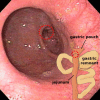Hyperammonemic encephalopathy caused by carnitine deficiency
- PMID: 18080167
- PMCID: PMC2359173
- DOI: 10.1007/s11606-007-0473-0
Hyperammonemic encephalopathy caused by carnitine deficiency
Abstract
Carnitine is an essential co-factor in fatty acid metabolism. Carnitine deficiency can impair fatty acid oxidation, rarely leading to hyperammonemia and encephalopathy. We present the case of a 35-year-old woman who developed acute mental status changes, asterixis, and diffuse muscle weakness. Her ammonia level was elevated at 276 microg/dL. Traditional ammonia-reducing therapies were initiated, but proved ineffective. Pharmacologic, microbial, and autoimmune causes for the hyperammonemia were excluded. The patient was severely malnourished and her carnitine level was found to be extremely low. After carnitine supplementation, ammonia levels normalized and the patient's mental status returned to baseline. In the setting of refractory hyperammonemia, this case illustrates how careful investigation may reveal a treatable condition.
Figures




Similar articles
-
Starting stiripentol in adults with Dravet syndrome? Watch for ammonia and carnitine.Epilepsia. 2020 Nov;61(11):2435-2441. doi: 10.1111/epi.16684. Epub 2020 Oct 21. Epilepsia. 2020. PMID: 33084037
-
L-Carnitine supplementation to reverse hyperammonemia in a patient undergoing chronic valproic acid treatment: A case report.J Int Med Res. 2017 Jun;45(3):1268-1272. doi: 10.1177/0300060517703278. Epub 2017 Apr 20. J Int Med Res. 2017. PMID: 28425821 Free PMC article.
-
Usefulness of Carnitine Supplementation for the Complications of Liver Cirrhosis.Nutrients. 2020 Jun 29;12(7):1915. doi: 10.3390/nu12071915. Nutrients. 2020. PMID: 32610446 Free PMC article. Review.
-
Reversible weakness and encephalopathy while on long-term valproate treatment due to carnitine deficiency.BMJ Case Rep. 2015 Sep 2;2015:bcr2015210727. doi: 10.1136/bcr-2015-210727. BMJ Case Rep. 2015. PMID: 26336183 Free PMC article.
-
Carnitine in the treatment of valproic acid-induced toxicity.Clin Toxicol (Phila). 2009 Feb;47(2):101-11. doi: 10.1080/15563650902752376. Clin Toxicol (Phila). 2009. PMID: 19280426 Review.
Cited by
-
Clinical Relevance and Cost-Savings of Levocarnitine Versus Ammonul in the Management Of Hyperammonemia in a Cancer Patient: The Impact of a Clinical Pharmacist.P T. 2018 Jan;43(1):52-56. P T. 2018. PMID: 29290677 Free PMC article.
-
Hyperammonemia in Inherited Metabolic Diseases.Cell Mol Neurobiol. 2022 Nov;42(8):2593-2610. doi: 10.1007/s10571-021-01156-6. Epub 2021 Oct 19. Cell Mol Neurobiol. 2022. PMID: 34665389 Free PMC article. Review.
-
Liver injury without liver failure in COVID-19 patients: how to explain, in some cases, elevated ammonia without hepatic decompensation.Crit Care. 2020 Jun 16;24(1):352. doi: 10.1186/s13054-020-03088-x. Crit Care. 2020. PMID: 32546201 Free PMC article. No abstract available.
-
Malignant cerebral edema secondary to hyperammonemia in setting of acquired carnitine deficiency.Neurol Clin Pract. 2020 Oct;10(5):e41-e43. doi: 10.1212/CPJ.0000000000000742. Neurol Clin Pract. 2020. PMID: 33299676 Free PMC article. No abstract available.
-
Failure of carnitine in improving hepatic nitrogen content in alcoholic and non-alcoholic malnourished rats.Clinics (Sao Paulo). 2010;65(9):877-83. doi: 10.1590/s1807-59322010000900011. Clinics (Sao Paulo). 2010. PMID: 21049216 Free PMC article.
References
-
- {'text': '', 'ref_index': 1, 'ids': [{'type': 'DOI', 'value': '10.1093/hmg/8.12.2247', 'is_inner': False, 'url': 'https://doi.org/10.1093/hmg/8.12.2247'}, {'type': 'PubMed', 'value': '10545605', 'is_inner': True, 'url': 'https://pubmed.ncbi.nlm.nih.gov/10545605/'}]}
- Koizumi A, Nozaki J, Ohura T, et al. Genetic epidemiology of the carnitine transporter OCTN2 gene in a Japanese population and phenotypic characterization in Japanese pedigrees with primary systemic carnitine deficiency. Hum Mol Genet. 1999;8:2247–54. - PubMed
-
- {'text': '', 'ref_index': 1, 'ids': [{'type': 'DOI', 'value': '10.1203/00006450-199711000-00005', 'is_inner': False, 'url': 'https://doi.org/10.1203/00006450-199711000-00005'}, {'type': 'PubMed', 'value': '9357927', 'is_inner': True, 'url': 'https://pubmed.ncbi.nlm.nih.gov/9357927/'}]}
- Pons R, Carrozzo R, Tein I, et al. Deficient muscle carnitine transport in primary carnitine deficiency. Pediatr Res. 1997;42:583–7. - PubMed
-
- {'text': '', 'ref_index': 1, 'ids': [{'type': 'DOI', 'value': '10.1203/00006450-198305000-00003', 'is_inner': False, 'url': 'https://doi.org/10.1203/00006450-198305000-00003'}, {'type': 'PubMed', 'value': '6682967', 'is_inner': True, 'url': 'https://pubmed.ncbi.nlm.nih.gov/6682967/'}]}
- Glasgow AM, Engel AG, Bier DM, et al. Hypoglycemia, hepatic dysfunction, muscle weakness, cardiomyopathy, free carnitine deficiency and long-chain acylcarnitine excess responsive to medium chain triglyceride diet. Pediatr Res. 1983;17:319–26. - PubMed
-
- {'text': '', 'ref_index': 1, 'ids': [{'type': 'PubMed', 'value': '6538002', 'is_inner': True, 'url': 'https://pubmed.ncbi.nlm.nih.gov/6538002/'}]}
- Di Donato S, Pelucchetti D, Rimoldi M, et al. Systemic carnitine deficiency: clinical, biochemical, and morphological cure with L-carnitine. Neurology. 1984;34:157–62. - PubMed
-
- {'text': '', 'ref_index': 1, 'ids': [{'type': 'DOI', 'value': '10.1067/mpd.2001.111813', 'is_inner': False, 'url': 'https://doi.org/10.1067/mpd.2001.111813'}, {'type': 'PubMed', 'value': '11295726', 'is_inner': True, 'url': 'https://pubmed.ncbi.nlm.nih.gov/11295726/'}]}
- Wilcken B, Wiley V, Sim KG, Carpenter K. Carnitine transporter defect diagnosed by newborn screening with electrospray tandem mass spectrometry. J Pediatr. 2001;138:581–4. - PubMed
Publication types
MeSH terms
Substances
LinkOut - more resources
Full Text Sources
Medical

